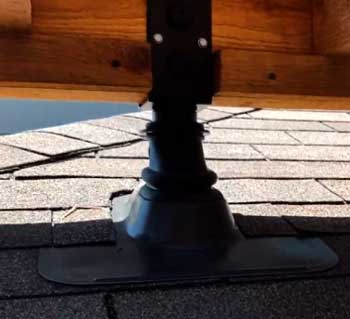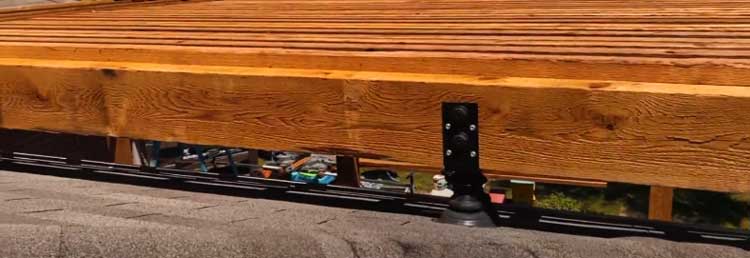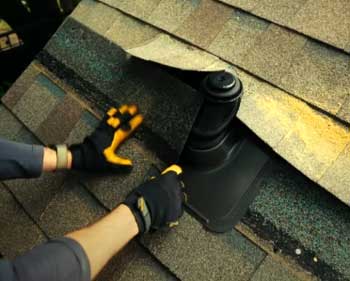When it comes to adding a roof to your patio, pergola, or any outdoor structure, choosing the right roof riser is crucial. I’ve learned this the hard way after working on several projects where the roof just didn’t have the right pitch or height.
If you’re planning a similar project, the SkyLift Roof Riser is worth considering. This code-approved roof riser is designed for ease of installation and provides a reliable, structural method for attaching patio covers, pergolas, and shade structures to your house.
If you’re interested in purchasing the SkyLift Roof Riser, I highly recommend checking out the official website or reputable home improvement stores like Home Depot or Lowe’s. These platforms often offer the best prices and customer service for this kind of specialized hardware.
My Experience With The SkyLift Roof Riser

I’ve always enjoyed working on home improvement projects, and after deciding to add a pergola to my backyard, I knew I needed something to elevate the roof and give it the right pitch.
That’s when I came across the SkyLift Roof Riser.
It promised to add the additional slope I needed while being structurally sound and easy to install.
After using it, I can confidently say it delivered on its promises.
The installation was straightforward. Despite not being a professional contractor, I found the process quite manageable. The brackets are designed to fit 1.5″ standard vent flashing, which made attaching them to the roof simple.
What really stood out to me was how secure the roof felt after everything was in place. The added height not only improved the look of the structure but also provided better water drainage, which is essential for longevity.
However, not everything was perfect. While the product itself is strong and does the job well, the aesthetic aspect leaves something to be desired.
The brackets are quite visible, and although they come with a black, powder-coated finish, they can still look a bit bulky and out of place depending on your roof’s design. I also wish the kit included black fasteners instead of galvanized ones to better match the overall look.
Pros of The SkyLift Roof Riser

- Ease of Installation: One of the biggest advantages of the SkyLift Roof Riser is how easy it is to install. Whether you’re a professional or a DIY enthusiast, you’ll find the process straightforward. The brackets fit well with standard vent flashing, making the attachment process smooth.
- Structural Integrity: These roof risers are professionally engineered and university-tested, so you can trust that they’ll hold up well over time. They provide a secure attachment method that increases both the height and pitch of your patio or pergola roof, leading to better water runoff and a longer-lasting structure.
- Improved Water Drainage: By elevating the roof, the SkyLift Roof Riser improves water drainage significantly. This is particularly beneficial if you live in an area with heavy rainfall, as it prevents water from pooling on your roof, which can cause damage over time.
- Enhanced Appearance: While the brackets themselves may not be the most aesthetically pleasing, the overall effect of a raised roof is undeniably attractive. It gives your outdoor structure a more finished, professional look that can enhance your home’s curb appeal.
- Customer Support: I had a few questions during installation, and I was pleasantly surprised by the manufacturer’s customer service. They were quick to respond and provided clear, helpful instructions that made the process even easier.
Cons of The SkyLift Roof Riser
- Aesthetics: As mentioned earlier, the brackets are not the most attractive. They are quite visible and can look bulky, especially if your roof design is on the sleeker side. While the black powder-coated finish helps, it’s not enough to make them blend seamlessly with all roof types.
- Cost: The SkyLift Roof Riser is not cheap, especially if you’re working on a large project that requires multiple brackets. For what it is—a metal bracket—it does feel a bit pricey. However, considering the structural benefits, it’s a cost that many might find justifiable.
- Limited Fastener Options: The kit includes galvanized fasteners, which are functional but not the best choice aesthetically. Black fasteners would have been a better option to match the brackets and create a more cohesive look.
Tips For SkyLift Roof Riser
Maintaining your SkyLift Roof Riser and the structure it supports is key to ensuring longevity. Here are a few tips based on my experience:

- Regular Inspections: Periodically check the brackets and fasteners for any signs of rust or wear. While the powder-coated finish is designed to resist corrosion, it’s still a good idea to keep an eye on it, especially in areas with harsh weather conditions.
- Clean Debris: Make sure to clear any debris from your roof regularly. Leaves, twigs, and other materials can accumulate around the brackets and cause water to pool, which might lead to rusting over time.
- Reapply Sealant: If you notice any gaps or potential leak points around the brackets, reapply a waterproof sealant. This will help prevent water from seeping into your roof structure, protecting both the riser and the roof itself.
- Touch Up the Paint: If you see any chips or scratches on the powder-coated finish, touch them up with black paint designed for metal. This will keep the brackets looking good and prevent rust from forming.
Comparison With Other Brands
When I was researching roof risers, I looked into a few other brands as well. Here’s how the SkyLift Roof Riser compares:
- Simpson Strong-Tie Roof Riser: Simpson Strong-Tie is a well-known brand in the home improvement space, and their roof riser brackets are also highly regarded. They offer similar structural support, but I found their installation process to be slightly more complicated than SkyLift’s. Additionally, the aesthetic issue is still present with Simpson’s products, though they do offer more variety in terms of finish.
- EZ-Riser Roof Brackets: EZ-Riser is another option that promises easy installation and good structural support. However, I found that their brackets were not as robust as SkyLift’s, particularly for larger projects. They are a bit cheaper, which might appeal to those on a budget, but you might be sacrificing some durability.
- QuickJacks Roof Brackets: QuickJacks offers a unique take on roof risers, with a focus on quick and easy adjustments. While they are convenient, I found that they didn’t provide the same level of structural integrity as SkyLift. They are better suited for temporary installations rather than permanent structures like a pergola or patio cover.
Frequently Asked Questions (FAQ)
The spacing of roof risers depends on the structure you’re building. Generally, they should be placed at regular intervals to evenly distribute the load of the roof. For most applications, placing them 4 to 6 feet apart works well, but it’s always best to consult with the manufacturer’s guidelines or a structural engineer to determine the exact spacing needed for your specific project.
A roof riser is a bracket or similar device used to elevate the height of a roof structure. It’s typically installed where a new roof, such as a patio or pergola cover, needs to attach to an existing building. The riser provides additional height and pitch, improving water runoff and enhancing the overall appearance of the structure.
The main advantage of using a top riser like the SkyLift Roof Riser is that it provides structural support while elevating the roof height and pitch. This not only improves water drainage but also enhances the visual appeal of your outdoor structure. Additionally, it allows for better airflow under the roof, which can help reduce heat buildup in the covered area.
The primary purpose of a roof riser is to elevate the roof, either to increase its height or to change its pitch. This is particularly useful in areas with heavy rainfall, as it improves water drainage and reduces the risk of water damage. Roof risers also allow for more headroom underneath the structure, making the space more usable and comfortable.
Conclusion: Should You Buy the SkyLift Roof Riser?
After using the SkyLift Roof Riser for my pergola project, I can say that it’s a solid choice for anyone looking to add height and pitch to their outdoor structures. While it has some minor drawbacks in terms of aesthetics and cost, the ease of installation and structural integrity it provides more than make up for these.
If you’re planning to build a patio cover, pergola, or any similar structure, the SkyLift Roof Riser is definitely worth considering. I recommend purchasing it from reputable home improvement stores like Home Depot or Lowe’s, where you can often find the best deals and customer service.
In the end, the SkyLift Roof Riser offers a practical solution to common roofing challenges, making your project easier and more efficient. Whether you’re a seasoned professional or a DIY enthusiast like me, this product is sure to meet your needs.
